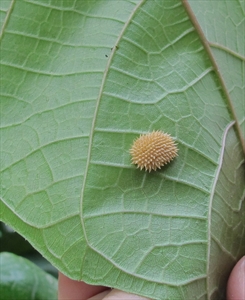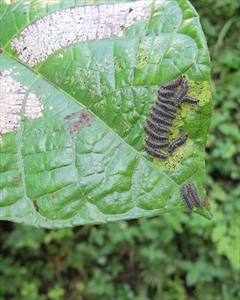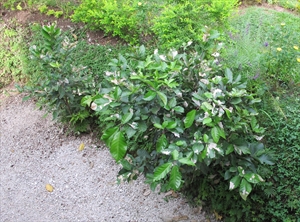Fig-leaf beetles
Pacific Pests, Pathogens, Weeds & Pesticides - Online edition
Pacific Pests, Pathogens, Weeds & Pesticides
Ficus sandpaper cabbage beetle (238)
The genus is Poneridia (family Chrysomelidae); there are several similar species, but not all the species of Poneridia feed on figs.
Fig-leaf beetles are recorded from Australia, Indonesia (South Maluku), Papua New Guinea, and Solomon Islands.
Fig-leaf beetles feed only on Ficus (including the commercial fig). In Papua New Guinea, the fig-leaf beetle is a pest of sandpaper cabbages, the young leaves of which are eaten as a vegetable.
The most obvious damage is done by the larvae which strip the surfaces of leaves, they skeletonise them (Photo 1). The adults chew the edges of the leaves, which produces relatively less damage compared to that caused by the larvae.
Eggs are salomon pink, conical, tapering to a point, laid in roughly circular masses, 10-12 mm diameter, on the under side of leaves (Photo 2). The masses contain approximately 100 eggs. They hatch giving rise to grubs with legs (larvae) that are at first yellow and then black. Often they line up along the edge of the leaf to feed (Photo 3). The larvae have prominent hairs, and grow to about 12 mm. When mature, they fall to the ground, and pupate at the base of the tree.
The adults of all species of fig-leaf beetles are mostly brown with partly reddish heads and legs, and dense short hairs on the wing cases or 'elytra' (Photo 5).
The damage done by the larvae to the small shrubby trees can be extensive (Photos 6). The damage usually occurs on the older leaves, leaving the younger ones to be plucked for eating. Destruction of the older leaves is likely to slow shoot production, but by how much is unknown as there has been no research on this pest.
Look for silver-grey leaf patches where the leaf surface has been removed. Look for the black larvae with spines, especially on the upper surface of the leaves.
CULTURAL CONTROL
Ficus sandpaper cabbages are rarely planted; mostly the shoots are collected from plants growing in the wild. This means that control measures are rarely applied against fig-leaf beetles. However, if management of the beetles was required, cultural control measures would be the most appropriate. Of those available, do the following:
- Hand pick the beetles and/or grubs, and destroy them, or squash them on the leaves.
- Cut off the leaves or entire shoots if the beetles and/or the grubs are too numerous for hand picking. Do this carefully, capturing the adult beetles, preventing them from breeding on other shoots.
- Prune the trees to head height so that collecting the insects and/or removing shoots can be done easily.
CHEMICAL CONTROL
This is not recommended as the leaves are mostly collected from plants growing in the wild. If needed, pyrethrum, derris or malathion would be suitable.
--------------------
Note, derris (Derris species) contains rotenone, an insecticide, often used as a fish poison; it should be used with caution. The commercial derris insecticide is made from Derris elliptica.
____________________
When using a pesticide, always wear protective clothing and follow the instructions on the product label, such as dosage, timing of application, and pre-harvest interval. Recommendations will vary with the crop and system of cultivation. Expert advice on the most appropriate herbicides to use should always be sought from local agricultural authorities.
AUTHOR Grahame Jackson
Information from Chris Reid (pers. comm.), Australian Museum, Sydney.
Produced with support from the Australian Centre for International Agricultural Research under project PC/2010/090: Strengthening integrated crop management research in the Pacific Islands in support of sustainable intensification of high-value crop production, implemented by the University of Queensland and the Secretariat of the Pacific Community.









